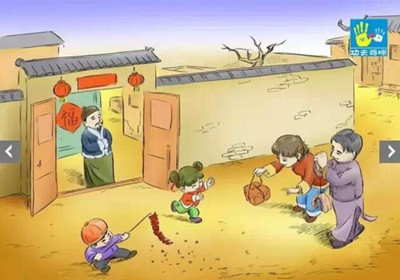"Dao" so you have the banner spring posted upside down, it implies that spring has arrived, "chundao".
“到”,這樣你把春聯(lián)顛倒著貼就意味著春天到了,“春到”。
A common Chinese saying which is seen on many banners also contains a play on words "niannianyouyu ", when read aloud sounds like have fish every year.
常見(jiàn)的中國(guó)說(shuō)這是看到很多橫幅還包含一個(gè)文字游戲“年年有魚(yú)”,大聲念起來(lái)像每天都有魚(yú)吃。
The meaning of this saying actually comes from another homophone Chinese characters "yu" which means fish sounds exactly like the Chinese character that means of abundance, the banner means abundance throughout the year.
這話的意思其實(shí)是來(lái)自另一個(gè)同音漢字“余”,這意味著“魚(yú)”聽(tīng)起來(lái)就像“豐富”的漢字,這春聯(lián)意味著一年富足。
Sometimes it's written as abundance and sometimes as fish, usually accompanied by fish swimming around the poster.
有時(shí)寫(xiě)“魚(yú)”或“余”的時(shí)候通常伴隨著魚(yú)在游動(dòng)的海報(bào)。
Whether it's an abundance through the year or just an abundance of fish through the year, the Chinese have always liked paste these banners come holiday season.
無(wú)論是一年富足還只是一年富足的魚(yú),中國(guó)人總是喜歡在假期將至?xí)r粘貼這些對(duì)聯(lián)。
Though there is no longer the looming threat of Nian the beast, people still hang these posters wish people joy, prosperity and good fortune throughout the year.
雖然再?zèng)]有野獸“年”迫在眉睫的威脅,人們?nèi)匀毁N這些海報(bào),祈盼一年歡樂(lè)、繁榮和好運(yùn)。
So, Alina, for Westerners, Christmas is our most important celebration and we get lots of presents, what do you guys get at Chinese New Year?
愛(ài)麗娜,對(duì)西方人來(lái)說(shuō),圣誕節(jié)是我們最重要的慶祝活動(dòng),我們會(huì)收到很多禮物,你們?cè)谥袊?guó)新年會(huì)收到什么呢?
Well, Ben, in Chinese families we give each other red packets with money inside.
本,在中國(guó)家庭中,我們給彼此裝著錢(qián)的紅包。
Unlike the Western custom of giving presents, during Chinese New Year, it is customary practice to give and receive red packets a hong bao in Chinese.
不同于西方送禮物的習(xí)俗,在中國(guó)新年期間,慣常的做法是派發(fā)和接收紅包。
This is a small red rectangular envelope for putting money even to give away as a gift.
這是一個(gè)小的紅色矩形的信封,把錢(qián)放在里面作為禮物贈(zèng)送。
The envelope is red because in traditional Chinese culture, red is considered a lucky color, it's believed to wipe off evil spirits and to bring good fortune to the receiver.
信封之所以是紅色的,是因?yàn)樵谥袊?guó)傳統(tǒng)文化中,紅色被認(rèn)為是幸運(yùn)的顏色,它被認(rèn)為除去惡靈,給接受者帶來(lái)好運(yùn)。
Hence most red packets are decorated with our species Chinese symbols or characters such as happiness and prosperity.
因此大多數(shù)紅包都裝飾著人類(lèi)幸福和繁榮等中文符號(hào)或文字。
Today, red packets come in all kinds of different designs besides the more traditional ones.
今天,紅包除了傳統(tǒng)的種類(lèi),還有各種不同的設(shè)計(jì)。
Traditionally the older generation gives the red packet to the younger generation, parents, grandparents and married members of the family would give the red packet to the children and grandchildren and unmarried family members.
在傳統(tǒng)中,老一輩給年輕的一代紅包,父母、祖父母和已婚家庭的成員會(huì)給子孫后代和未婚家庭成員紅包。

Nowadays these practice exchange to close friends, neighbors and even some companies give away year-end bonuses in an red packet.
現(xiàn)在,這些紅包的交換使得朋友和鄰居更加親近,甚至有些公司用紅包派發(fā)年終獎(jiǎng)。
The amount of money placed inside to red packet varies depending on the relationship between a giver and the receiver, but it must be in even numbers.
紅包里的錢(qián)數(shù)多少取決于給予者和接受者之間的關(guān)系,但它必須是偶數(shù)。
Amount starting or ending with 8 are common, 8 or "ba" in Chinese symbolizes prosperity, because its rhyme with character "fa" that uses in a phrase "facai", which means generate wealth.
8是常見(jiàn)的開(kāi)始或結(jié)尾,8或八在中國(guó)象征著繁榮,因?yàn)樗捻嵚膳c短語(yǔ)“發(fā)財(cái)”中的字符“發(fā)”相同,這意味著創(chuàng)造財(cái)富。
It is also customary to use brand new notes for the red packets.
錢(qián)包也通常習(xí)慣使用紅包的嶄新的紙幣。


